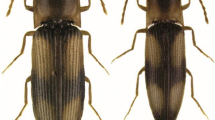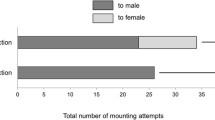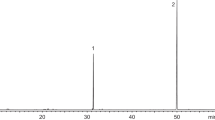Abstract
The click beetle Idolus picipennis represents the only species of its genus in Europe, where it is widely distributed but is rare and only occurs locally. In order to identify its sex pheromone we investigated gland extracts of females from populations in southern Germany. GC/MS analyses revealed two distinct types of gland compositions that correspond to slight but consistent morphological differences in the respective beetles. Extracts of one type contain four compounds, geranyl hexanoate (~ 40 %), (Z,E)-farnesyl hexanoate (~ 10 %), (E,E)-farnesyl hexanoate (~ 40 %), and (E,E)-farnesyl octanoate (~ 10 %), and this type belongs to the authentic I. picipennis (Bach 1852). Extracts of a second type contain neryl hexanoate (~10 %) and neryl octanoate (~ 90 %), and this type belongs to an Idolus species that apparently has been overlooked to date, presumably due to similarity with the authentic I. picipennis and insufficient material in collections. Synthetic blends of the identified compounds in their naturally-occurring ratios, as well as the main compounds alone, proved to be highly attractive to swarming males of the respective species in the field. A strong species-specific attraction also was observed in a locality where both species co-occur, thus confirming effective reproductive isolation. This study shows the potential of sex pheromones for monitoring rare and threatened insects as well as for detecting hitherto unknown cryptic species.







Similar content being viewed by others
References
Bach M (1852) Käferfauna für Nord- und Mitteldeutschland, mit besonderer Rücksicht auf die preussischen Rheinlande. Band 2. J. Hölscher, Koblenz
Bartsch D, Bettag E, Bläsius R, Blum E, Kallies A, Spatenka K, Weber F (1997) Sesiidae (Glasflügler). In: Ebert G (ed) Die Schmetterlinge Baden-Württembergs 5. E. Ulmer, Stuttgart, pp 61–200
Cate PC (2007) Elateridae. In: Löbl I, Smetana A (eds) Catalogue of Palaearctic Coleoptera, vol 4. Apollo Books, Stenstrup, pp 89–209
El-Sayed A (2009) The Pherobase. http://www.pherobase.com
Geiser R (1998) Rote Liste der Käfer (Coleoptera), Diversicornia. In: Bundesamt für Naturschutz (ed.) Rote Liste der gefährdeten Tiere Deutschlands. Schriftenr. Landschaftspfl. Natursch. 55, Bonn-Bad Godesberg, pp. 194–201
Horion A (1953) Faunistik der mitteleuropäischen Käfer, Band III: Malacodermata, Sternoxia (Elateridae bis Throscidae). G. Frey, München
Laibner S (2000) Elateridae of the Czech and Slovak Republics. Kabourek, Zlín
Larsson MC, Hedin J, Svensson GP, Tolasch T, Francke W (2003) Characteristic odor of Osmoderma eremita identified as a male-released pheromone. J Chem Ecol 29:575–587
Lohse GA (1979) 34. Familie: Elateridae. In: Freude H, Harde K, Lohse GA (eds) Die Käfer Mitteleuropas, Band 6: Diversicornia. Goecke & Evers, Krefeld, pp 103–186
Merivee E, Erm A (1993) Studies on sex pheromone gland morphology and pheromone components in female elaterid beetles Agriotes obscurus L. and Agriotes lineatus L. (Coleoptera. Elateridae). Proc Est Acad Sci Biol Ecol 42:108–117
Millar JG, McElfresh JS, Romero C, Vila M, Neus M-M, Lopez-Vaamonde C (2010) Identification of the sex pheromone of a protected species, the Spanish Moon Moth Graellsia isabellae. J Chem Ecol 36:923–932
Priesner E, Ryrholm N, Dobler G (1989) Der Glasflügler Synanthedon polaris (Stgr.) in den schweizer Hochalpen, nachgewiesen mit Sexualpheromon. Nachrichtenbl Bayer Ent 38:89–97
Pühringer F, Ryrholm N (2000) Pheromonanflug europäischer Glasflügler (Lepidoptera, Sesiidae). Mitt Ent Arbg Salzkammergut 3:65–72
Tolasch T (2008) Sex pheromone of Ectinus aterrimus (Linné, 1761) (Coleoptera: Elateridae). Chemoecology 18:177–180
Tolasch T, von Fragstein M, Steidle JLM (2007) Sex pheromone of Elater ferrugineus L. (Coleoptera: Elateridae). J Chem Ecol 33:2156–2166
Tolasch T, von Fragstein M, Steidle JLM (2010) Sex pheromone of Agriotes acuminatus (Stephens, 1830). (Coleoptera: Elateridae). J Chem Ecol 36:314–318
Tóth M, Furlan L, Yatsynin VG, Ujvary I, Szarukan I, Imrei Z, Subchev M, Tolasch T, Francke W (2002) Identification of sex pheromone composition of click beetle Agriotes brevis Candeze. J Chem Ecol 28:1641–1652
Tóth M, Furlan L, Yatsynin VG, Ujvary I, Szarukan I, Imrei Z, Tolasch T, Francke W, Jossi W (2003) Identification of pheromones and optimization of bait composition for click beetle pests (Coleoptera: Elateridae) in Central and Western Europe. Pest Manag Sci 59:417–425
Yatsynin VG, Rubanova EV, Okhrimenko NV (1996) Identification of female-produced sex pheromones and their geographical differences in pheromone gland extract composition from click beetles (Col., Elateridae). J Appl Entomol 120:463–466
Yu JS, Kleckley TS, Wiemer DF (2005) Synthesis of farnesol isomers via a modified Wittig procedure. Org Lett 7:4803–4806
Author information
Authors and Affiliations
Corresponding author
Rights and permissions
About this article
Cite this article
Tolasch, T., König, C., von Fragstein, M. et al. Identification of the Sex Pheromone of Idolus picipennis (Bach, 1852) Revealed the Presence of a Cryptic Sibling Species. J Chem Ecol 39, 1433–1440 (2013). https://doi.org/10.1007/s10886-013-0360-6
Received:
Revised:
Accepted:
Published:
Issue Date:
DOI: https://doi.org/10.1007/s10886-013-0360-6




